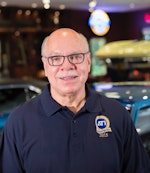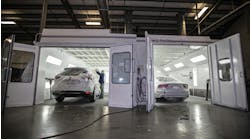Moving beyond fixing cars to providing great customer experiences
This month we examine a challenge we all face, but few of us realize what it does to our customers and associates. Let’s listen to a former shop owner and now ATI Performance Coach, Charlene L. Parlett, AM.
I grew up in a mechanic’s home. During the day my father was a manager at the largest motorcycle dealership in the state. Evenings and weekends, he worked out of his home garage on British and European motorcycles. Fewer and fewer places wanted to deal with these bikes so he got referrals from a lot of shops and owners’ clubs. Most weekends I hung out in the garage with my dad helping him take apart an engine, clean parts in the varsol tank, or shine up a bike that was ready for the owner to pick up. Every weekend there would be five to ten people hanging out at the garage. One was a journalist for a major Washington, DC, paper. Another owned several businesses. Several master auto techs were also among the regulars, fascinated with the similarities and differences between working on these (now classic) motorcycles and automobiles. The conversations were rarely about the bikes — they were often (respectful) dialog on different political views, the latest findings in National Geographic or Popular Mechanics, and a lot of good-hearted ribbing about whose bike was going to take awards at the next event.
|
LIMITED TIME OFFER: Customer Service Evaluation Tool |
| To find out where your shop stands, get ATI’s Customer Service Evaluation Tool. Answer a series of questions, get a score and see how you rank on the customer service scale. Simply go to www.ationlinetraining.com/2020-02 for a limited time. |
These men and women loved spending a Sunday afternoon hanging out in a motorcycle shop. My dad’s garage was nothing special. There was no spotless waiting room, no free snacks, and everyone was expected to work while they were there, either taking something apart or cleaning up. But my dad made them feel welcomed, accepted, fun, challenged. They were there because it felt good to bring their bikes to him, and their friends to him, and their friends’ friends to him.
Remember why you started a business
When I ask shop owners what made them want to own their own shop, their big WHYs are almost always, “I knew I could take better care of customers than the person I worked for,” “I wanted to spend more time with my family,” or “Owning my own shop was always a dream of mine.” I rarely meet a shop owner who says they opened their shop to get rich. While having more money is always a factor, it is never their first answer to why they became a shop owner.
For me, owning my own shop was all about great customer service. I wanted to be the place people knew they could trust to be honest, fair, and do great work. And it was. But after a few years of daily grinding, we forgot what our real reason for starting the business was. We worked from open to close and many hours beyond that. We began to see customers and employees as necessary evils. We took home smaller paychecks than we ever did as employees of someone else.
We started to think all we did was fix cars. The danger is the cheapest guy in town does too. I wanted to be more than that to my customers. We had to remember our big WHY.
“People buy feelings . . . how your business anticipates those feelings and satisfies them is your product.”1
Treat customers how you’d like to be treated
Think about a restaurant you really love. Is the food extraordinary? Maybe — but if the tables are filthy, the bathroom scary, the servers smell like ashtrays, and your order is wrong, it won’t matter how good the food is — you won’t be back. So, think about it again. Do you look forward to going there? Do you go often enough that the host smiles and recognizes you? Do you have a favorite drink they bring you without asking? Does it have mood lighting, attractive décor, aromas that entice? The more you think about it, the more the food becomes secondary. Yes, it has to be good food prepared correctly — but the good food isn’t the main reason you love to go there. You go there because it feels good to go there — soothing, romantic, exciting, appreciated.
Think about the worst place you ever worked. Why was it the worst? Did your manager treat you badly? Were you constantly being asked to put in extra hours when you wanted to go home? Did you dread going to work each day? The worst thing about it was probably not the job duties; it was how you felt about being there.
People buy feelings
Why should you care how people feel about your shop? Because people (both customers and employees) buy based on feelings.
How do your customers feel about you? Are they frequent visitors? Do they introduce friends and new neighbors to you? Do they leave a review about their wow experience — or do you just fix their cars? If you review your database and the majority of customers never darken your door a second time, it’s probably because all you did was fix their car. You didn’t make them feel special, important, valued, appreciated. You made them feel like a transaction. Successful shops view each customer as a potential lifelong relationship. That first phone call or service is a first date; we want that second date, and third, and fourth. They can get their car fixed at a dozen other shops; they come back because it feels good to bring it back.
Another indication that your shop is creating a great customer experience is the score you get when you complete ATI’s Customer Service Evaluation Tool. The higher the score, the more likely that your shop is doing everything right to keep your customers happy. If you’re low on the scale, at least you’ll know that you have work to do and where to start.
Create an experience-centered culture
How does your crew feel about you? Do they show up early to chat with you and each other over coffee? Are they smiling throughout the day? If you want better productivity in the shop, evaluate why productivity is low. Do you have a training issue (head), a tools issue (hands), or a culture issue (heart)? If it is a culture issue, be honest with yourself about how that happened and what you need to do to fix it, because it’s already hurting your profitability. They’ll be more likely to stay long-term with you. A 2017 Gallup report states “The modern workforce knows what’s important to them and isn’t going to settle. Employees are willing to look and keep looking for a company whose mission and culture reflect and reinforce their values.”2 Your service advisor and technicians will be more productive and provide better customer service when they see their job as having significance, and something they look forward to each day.3 In the midst of the worst technician shortage we’ve ever faced, a positive work environment and a great manager/owner are non-negotiables in a technician’s decision to move to another shop.
How about you? Do you look forward to going to the shop? Or have the reasons you stepped into ownership been pushed to the side to make it through each day? Even a good shop owner with a positive attitude gets stuck in the weeds and forgets to make time to work on the big picture. So, take a step back and remember why you opened the doors on that first day. Was it to take care of people? Spend time with family? Give back to your community? Can your customers and team members feel that big WHY when they come in the doors? Or — do you just fix cars?
To find out where your shop stands, get ATI’s Customer Service Evaluation Tool. Answer a series of questions, get a score and see how you rank on the customer service scale. Simply go to www.ationlinetraining.com/2020-02 for a limited time.
Chris “Chubby” Frederick is the CEO and founder of the Automotive Training Institute. ATI’s 130 full-time associates train and coach more than 1,700 shop owners every week across North America to drive profits and dreams home to their families. Our 32 full-time Certified Performance coaches have helped our members earn over ONE BILLION DOLLARS in return on their coaching investment since ATI was founded. This month’s article was written with the help of former shop owner and ATI Performance Coach, Charlene Parlett, AM.
Sources:
- 1The E-Myth Revisited: Why Most Small Businesses Don't Work and What to Do About It, by Michael Gerber
- 2https://news.gallup.com/reports/199961/7.aspx
- 3https://www.forbes.com/sites/victorlipman/2013/09/23/surprising-disturbing-facts-from-the-mother-of-all-employee-engagement-surveys/#5686c7693120




